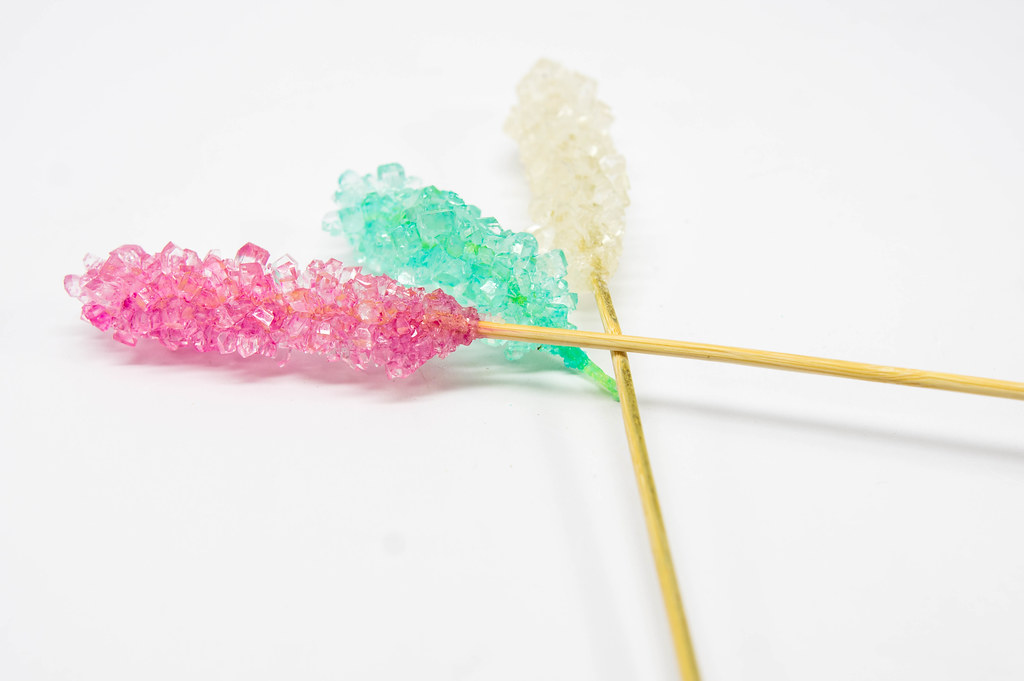Step 1
Boil 250 mL of water in a pan.
Step 2
Add about 300 g of sugar to the boiling water.
Step 3
Mix well with a wooden spoon until no more sugar is visible in the water.
Step 4
Continue to add more sugar (~ 300 g) whilst stirring until the sugar added is no longer dissolving in water.
Step 5
Allow the solution to cool for 10 minutes and then transfer the water into a glass cup.
Step 6
Dip the wooden stick into the water and roll it in some sugar.
Step 7
Submerge the skewer in the sugar solution and hold it by a peg. Make sure that the skewer is not touching the sides or the bottom of the cup.
Step 8
Leave this setup to cool without disturbing the solution.
Step 9
Wait a few days for the sugar crystals to start to appear.
Step 10
Once the crystals stop growing, use a butter knife to break the surface of the solution.
Step 11
Remove the crystals from the solution, hang them in an empty glass cup, and allow them to drip.
Step 12
Once this is all done, crystalline sugar is obtained.
To create candy with different colours, add food colour or flavourings to the sugar solution to have a greater variety of candy.
Instead of wooden sticks, make use of a piece of string or thread. Tape the string to a pencil and place the pencil across the lid of the jar.
Use caution when handling the warm water. Do this step with the help of an adult.
As one can easily observe when preparing tea, adding a tablespoon of sugar to the tea when it is cold causes only a portion of the sugar to dissolve as the rest ends up sinking to the bottom. Adding the same amount of sugar to a hot cup of tea, then the same amount of sugar dissolves in water fairly rapidly. This is due to the fact that the higher the temperature of a solvent, the greater the amount of solute that can be dissolved. However, after substantial addition of sugar to the hot tea, there comes a point where that particular volume of water is not able to dissolve any more sugar. This is referred to as a supersaturated solution.
Why is it important for the water to be heated?
Warmer water can dissolve more sugar.
Why is sugar added until no further sugar can be dissolved?
The resultant supersaturated solution is more likely to form sugar crystals.
Why is it important that the wooden stick should not touch the sides of the cup?
In order to give more space for the crystals to grow.
Why do we need to cover the stick with sugar?
To aid for the sugar to crystallise out of solution.
Does it make a difference if another solvent is used instead of water?
Yes. Different solvents have different solubilities which influence crystal formation.
Is it correct that the crystalline structure is the same for all solutes?
No, crystal structure depends on the solute
In this experiment, the chemical used to form crystals is sugar which is made up of a repetitive arrangement of the carbohydrate molecules, referred to as sucrose. Once you mix sugar and water, the sucrose molecules separate as they are attracted to the water molecules. A solution is formed when molecules of the solvent collide with molecules of the solution, if this is done with enough energy the solute molecules will be picked up by the solvent molecules, these are they known as being a solution
The solubility of a substance depends on the physical and chemical properties of both the solute (sugar) and the solvent (water). For example the larger the solute, the more difficult it is for the solvent molecules to surround them (a low surface area to volume ratio). Polarity of both the solute and the solvent also plays a role in solubility. Keeping in mind that ‘Like dissolves Like’, polar (where a molecule has a positively charged end and a negatively charged end) solutes will dissolve in polar solvents. However, if one substance is polar and the other non polar, the solute will not dissolve.
In a set volume of solvent, only a certain amount of solute can be dissolved at a particular temperature, this is when a solution becomes saturated. Any further addition of the solid will remain at the bottom of the solution.
http://www.solubilityofthings.com/basics/factors_affecting_solubility.php
Generally, an increase in the temperature of a liquid will increase its solubility. This is because as the liquid gets hotter the greater the energy the molecules that it is made of, resulting in more high energy impacts between the solvent and solute molecules and a greater likelihood of the solute molecules being removed. The resulting solution is referred to as an unstable supersaturated solution. This simply means that there is a greater amount of solute dissolved in the solvent at this higher temperature than the solvent can actually hold at room temperature. https://www.acs.org/content/acs/en/education/resources/highschool/chemmatters/past-issues/archive-2014-2015/candymaking.html
If you allow this solution to cool, the amount of sugar that can be dissolved in the water decreases, resulting in some of the sugar molecules coming out of solution and becoming visible. As the temperature continues to drop, more of the sugar will crystallise. Eventually, these crystals will start to cluster together and will attach to the wooden stick, leaving you with some delicious rock candy.
Sucrose has the chemical formula C12H22O11, and the sugar molecules are held together by relatively weak intermolecular forces.
Energy is required to disrupt the relatively weak intermolecular forces between sugar molecules, as well as the weak hydrogen bonds between the water molecules; both of these bonds need to be broken for a mixture to become a solution. This energy comes from random collisions between the solute and solvent molecules. Once these bonds are broken, the disassociated sugar molecules form in intermolecular bonds between the slightly polar sucrose molecules and the polar water molecules.
Upon cooling, the solubility of the water decreases, with less thermal energy, the system tries to compensate by forming chemical bonds to generate energy. Such bonds are formed by joining sucrose molecules together in an ordered and repetitive pattern, causing the sugar molecules to start to become visible as crystals. When these molecules start forming crystals around each other is referred to as nucleation. The greater the drop in temperature, the more sugar forming crystals form.
https://www.acs.org/content/acs/en/education/resources/highschool/chemmatters/past-issues/archive-2014-2015/candymaking.html
Dissolved sugar molecules need to interact with other sugar molecules to start crystalising, and as this movement is random this can be unpredictable. However, the use of a seed crystals (the sugar coating on the stick), can provide a surface for the nucleation process, speeding up crystallisation. This is because, when dissolved sugar comes in contact with a pre-formed crystal, the sugar molecules has a surface to form around.
The more sugar molecules that attach together, the greater the size of the crystals. The size of the final crystals depends on the substance used. For example, sugar crystals are a different size compared tp salt crystals.
http://chemguide.co.uk/atoms/structures/ionicstruct.html
Applications
A supersaturated solution leads to crystallisation and precipitation. Crystallisation is a common process that occurs in nature, however, such a process is also used in industry. Its main use is for purification, isolation, and recovery of solid materials from a solution. Another important use is for the production of crystals. Crystallisation remains one of the most cost-effective techniques for the production of salt.
https://en.wikipedia.org/wiki/Supersaturation#Application
Research
A major drawback encountered with pharmaceuticals is the difficulty in creating drugs which are soluble in the body’s fluids, but where the body needs the drugs. Pharmaceutical researchers use supersaturating drug delivery systems (SDDS), where a drug will be maintained for a longer period of time using precipitation inhibitors which stop the molecules from dissolving and to allow for more efficient oral bioavailability where the drug is needed.
The research is based on assessing methods in easing drug intestinal absorption of poorly soluble drugs. http://www.sciencedirect.com/science/article/pii/S0378517312010332
https://www.ncbi.nlm.nih.gov/pubmed/19373886
https://www.ncbi.nlm.nih.gov/pubmed/27518171
Does this experiment work only with sugar? Try the same method but replace sugar with salt and see if you manage to get salt crystals. [It is expected that the same outcome will be achieved.]
Make a comparison by following the same procedure but in this second set do not coat the wooden sticks with sugar prior to dipping into the solution. Is there a difference between the size of the crystals obtained in the two sets prepared? [This should make it more difficult for the crystals to form and smaller crystals should be obtained.]
Carry out the experiment again but without heating the water. Observe what happens. [The lack of heating prevents the water from becoming supersaturated, therefore, no crystals are expected to form.]



